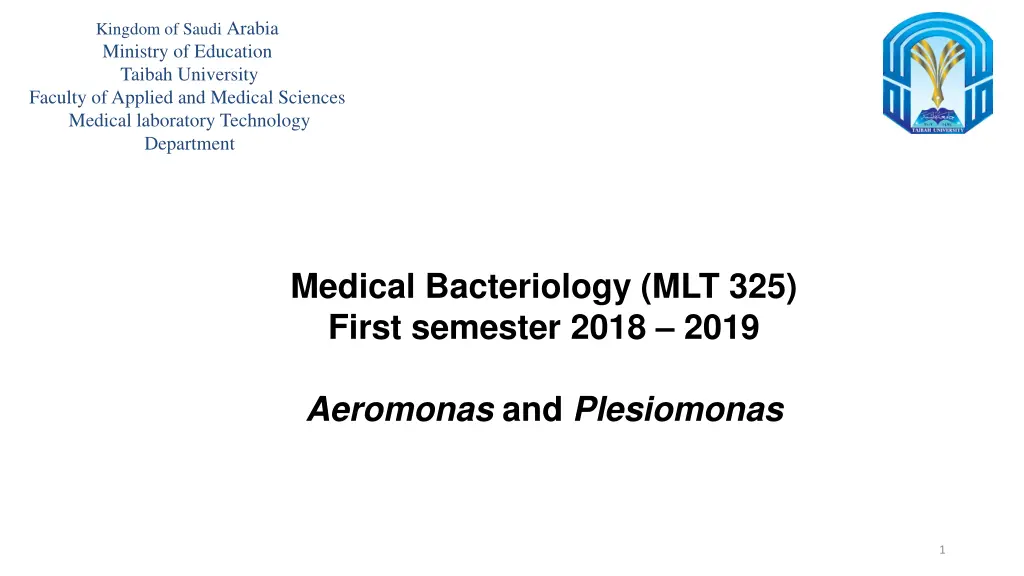
Aeromonas and Plesiomonas: Bacterial Pathogens Overview
"Learn about the general characteristics, virulence factors, and route of infection of Aeromonas bacteria, important zoonotic pathogens. Explore their impact on human health and the environment in this informative guide."
Download Presentation

Please find below an Image/Link to download the presentation.
The content on the website is provided AS IS for your information and personal use only. It may not be sold, licensed, or shared on other websites without obtaining consent from the author. If you encounter any issues during the download, it is possible that the publisher has removed the file from their server.
You are allowed to download the files provided on this website for personal or commercial use, subject to the condition that they are used lawfully. All files are the property of their respective owners.
The content on the website is provided AS IS for your information and personal use only. It may not be sold, licensed, or shared on other websites without obtaining consent from the author.
E N D
Presentation Transcript
Kingdom of Saudi Arabia Ministry of Education Taibah University Faculty of Applied and Medical Sciences Medical laboratory Technology Department Medical Bacteriology (MLT 325) First semester 2018 2019 Aeromonas and Plesiomonas 1
Aeromonads General characteristics Aeromonads Gram-negative rods, nonspore forming, and facultative anaerobes They are widely distributed in the soil, foodstuffs, and aquatic environment Humans carry Aeromonas species in the gastrointestinal tract They are important zoonotic pathogens of poikilotherms NOW, they are emerging as important human pathogens Aeromonas spp. particularly those associated with human infections are found in a wide variety of fresh produce, meat, and dairy products 2 http://www.gopetsamerica.com/bio/bacteria/aeromonas-hydrophila.aspx
Obligate aerobe Obligate anaerobe Facultative anaerobe 3
Aeromonas Virulence factors Fimbria, flagella, and capsule helps in the attachment of the bacteria to the host surface They then derive iron from the host using various iron-binding proteins such as siderophores to enable survival and multiplication of the pathogen within the host Survival within the host is followed by the production various exotoxins and enzymes such as proteases, elastases, lipases, and hemolysins to cause extensive cell and tissue destruction 4
https://www.google.com/search?q=fimbriae+flagella+bacteria&safe=strict&client=safari&rls=en&source=lnms&tbm=isch&sa=X&ved=0ahUKEwjL3Mei6pTeAhVHOhhttps://www.google.com/search?q=fimbriae+flagella+bacteria&safe=strict&client=safari&rls=en&source=lnms&tbm=isch&sa=X&ved=0ahUKEwjL3Mei6pTeAhVHOh oKHYoNB88Q_AUIDigB&biw=1280&bih=641#imgrc=mzz0C0kgFdQywM: 5
Aeromonas Route of infection The infectious dose of this organism is unknown Aeromonas are ubiquitous in water, including chlorinated drinking water and groundwater The organism has frequently been found in fish and shellfish and pets It has also been found in market samples of red meats (beef and lamb) and poultry They are important zoonotic pathogens of poikilotherms In addition to these consumable products, bivalves such as oysters and mussels are naturally bathed in estuary waters containing A. hydrophila, and through their filter-feeding process, they actually concentrate these bacteria within their meats Recreational activities such as boating, fishing, and diving can lead to infection through major or unapparent traumas 6
Aeromonas Pathogenesis They have been associated with diarrheal disease ranging from acute diarrhea in immunocompetent adults (healthy adults) to chronic diarrhea in children, elderly, and immunocompromised individuals Two distinct types of gastroenteritis have been associated with A. hydrophila: a cholera-like illness with a watery (rice and water) diarrhea and a dysenteric illness characterized by loose stools containing blood and mucus Aeromonads have been associated with skin and soft tissue infections, traumatic wound infections, and lower respiratory tract/urinary tract infections Aeromonas septicemia has been shown in patients having severe hepatic diseases, diabetes, cancer, leukemia, and immunosuppression due to other causes 8
Aeromonas diagnosis Negative Gram stain rod shaped A positive oxidase reaction No growth in nutrient broth with 6% NaCl Inability to grow on thiosulfate citrate bile sucrose agar helps in the differentiation of Aeromonadaceae from Vibrio and Pleisiomonas genera. There is another test .. An IgA antibody response to Aeromonas somatic lipopolysaccharides and exotoxins has been reported to be reliable example test . PCR is rapid, convenient, and specific for the identification of the pathogen 9 https://germsandworms.wordpress.com/microbes/vibrio-spp/aeromonas/
Aeromonas Treatment and control measurements Control Most of the infections caused by the Aeromonas spp. are gastrointestinal infections These can be easily prevented by: i. maintaining adequate sanitary conditions such as hand hygiene, efficient sewage disposal, and hygienic food preparation ii. iii. Adequate disposal of the diseased animal and water treatment can prevent the spread of Aeromonads iv. Continuous monitoring of the quality of water is essential to minimize the health risk due to Aeromonads Proper cooking of the food product also minimizes the transmission 10
Aeromonas Treatment and control measurements Treatment and antibiotic resistance Gastrointestinal diseases are generally self-limiting, and no antibiotic treatment is generally required. Treatment with rehydration therapy is generally adequate Antibiotic prophylaxis may however be required in immunocompromised patients They are susceptible to piperacillin, azlocillin, second and third generation cephalosporins, and carbapenems Most of the Aeromonas species are susceptible to aminoglycosides, tetracycline, chloramphenicol, trimethoprim-sulfamethoxazole, quinolones, and monobactams Aeromonads are universally resistant to the narrow-spectrum penicillin group of antibiotics such as penicillin, ampicillin, carbenicillin, and ticarcillin 11
